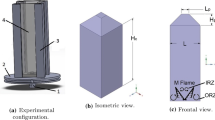Abstract
Université de Provence, Ecole Polytechnique Universitaire de Marseille, Département Mécanique Energétique, 5, rue Enrico Fermi, 13453 Marseille Cedex, France Abstract. A numerical study of reactive flow in a two dimensional axisymmetric nozzle, which ejects burnt gases out of a combustion chamber is presented. The lower pressure of ejected gases is adapted to higher ambient air by means of an oblique shock. This oblique shock leads to a boundary layer detachment and a fresh air re-circulation between the shear layer and the nozzle wall. In this mixing zone, the air flow oxygen reacts with burnt gases, whose composition is rich in hydrogen, reaction which is strongly exothermic. The increasing temperature may damage nozzle wall and leads to a performance reduction for the engine. The numerical method is based on a finite volume scheme and allows the resolution of Navier-Stokes equations for unsteady, compressible flows, taking into account the chemical reactions.
Access this chapter
Tax calculation will be finalised at checkout
Purchases are for personal use only
Preview
Unable to display preview. Download preview PDF.
Similar content being viewed by others
References
R. Benay, R Servel: Modélisation du décollement dans les tuyres surdétendues. Onera RT 41/4361 DAFE/N (1998)
C.R. Foster, F.B. Cowles: Experimental study of gas flow separation in over-expanded exhaust nozzles for rocket motors. Jet Propulsion Laboratory, Progress report 4-103 (1949)
C.A. Hunter: ‘Experimental, Theoretical, and Computational Investigation of Separated Nozzle Flows’. In: 34thAIAA/ASME/SAE/ASEE Joint Propulsion Conference and Exhibit, Cleveland, OH, July 13–15, 1998
P. Reijasse, M. Frey, O. J. Haidn: ‘Flow Physics and Side Loads in Highly Over-expanded Rocket Nozzles’. In: 2 ndONERA-DLR Aerospace Symposium at Berlin, Germany, June 15–16, 2000
V. Dutoit, D. Vuillamy: Étude de réchauffement de la tuyére d’échappement de la ligne oxygéne. SEP-23 165/96 (1996)
R.J. Kee, F.M. Rupley, J.A. Miller: The Chemkin Thermodynamic Data Base. Sandia Report SAND-8215B (1992)
K.K. Kuo: Principles of Combustion. (Wiley-Interscience 1986)
Y. Burtschell, M. Cardoso, D.E. Zeitoun: Numerical analysis of reducing driver gas contamination in impulse shock tunnels. AIAA Journal 39(12), 2357 (2001)
Author information
Authors and Affiliations
Editor information
Editors and Affiliations
Rights and permissions
Copyright information
© 2005 Tsinghua University Press and Springer-Verlag Berlin Heidelberg
About this paper
Cite this paper
Meister, L., Burtschell, Y., Zeitoun, D.E. (2005). Numerical study of reactive flow in an over-expanded nozzle: influence of wall temperature and altitude. In: Jiang, Z. (eds) Shock Waves. Springer, Berlin, Heidelberg. https://doi.org/10.1007/978-3-540-27009-6_183
Download citation
DOI: https://doi.org/10.1007/978-3-540-27009-6_183
Published:
Publisher Name: Springer, Berlin, Heidelberg
Print ISBN: 978-3-540-22497-6
Online ISBN: 978-3-540-27009-6
eBook Packages: Physics and AstronomyPhysics and Astronomy (R0)




